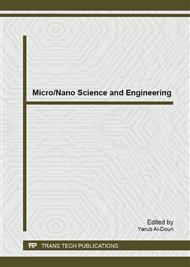p.8
p.13
p.18
p.23
p.28
p.33
p.38
p.43
p.48
Fresh State Behaviour of Cement Paste Containing Nano Kaolin
Abstract:
The application of nanomaterials in cement by replacement method in concrete is becoming a trend in cement research. The utilisation of nanosilica, nanoalumina, titanium oxide and others are proven to enhance properties of concrete. The major effect of nanomaterials is its size in which it contributes to the packing theory due to increase in the surface area. nanokaolin which comes from kaolin, was tansformed to the nanoform by using high energy milling. The process of developing nanokaolin by using high energy milling is referred to process top to bottom approach in nanoprocessing technique. In this research, the nanokaolin will be used as an additive in cement by 7% weight of cement. Four (4) cement replacement materials catered by using metakaolin on weight basis from 0, 10%, 20% and 30% will also be adopted. To determine the fresh state, cement paste contains nanokaolin and metakaolin are tested its standard consistency and setting time. The effect of the inclusion of the nanokaolin as additive in cement paste that also contains metakaolin as cement replacement material will be investigated. It was found the inclusion of 7% nanokaolin increases the water demand of the cement paste level of metakaolin replacement. In addition to that, the setting time namely initial and final set was been delayed as compared to that of plain OPC. The nanoparticles of nanokaolin and also finer particles of metakaolin increase the surface area and refining the internal structure of cement paste which reduce the flow capabilities of cement paste containing nanokaolin and metakaolin.
Info:
Periodical:
Pages:
28-32
Citation:
Online since:
April 2014
Authors:
Keywords:
Price:
Сopyright:
© 2014 Trans Tech Publications Ltd. All Rights Reserved
Share:
Citation:


